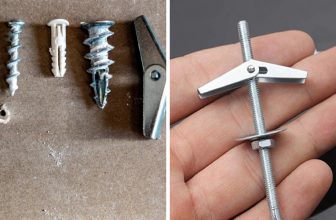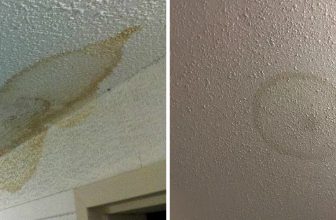How to Clean Ceiling Around Vents
Maintaining a clean and dust-free home is not just about what you see on the surface; it also involves tackling often-neglected areas like the ceiling around vents. Over time, these areas can accumulate dust, dirt, and even mold, affecting the air quality and overall cleanliness of your living space. In this article, we will delve into the essential steps on how to clean ceiling around vents.
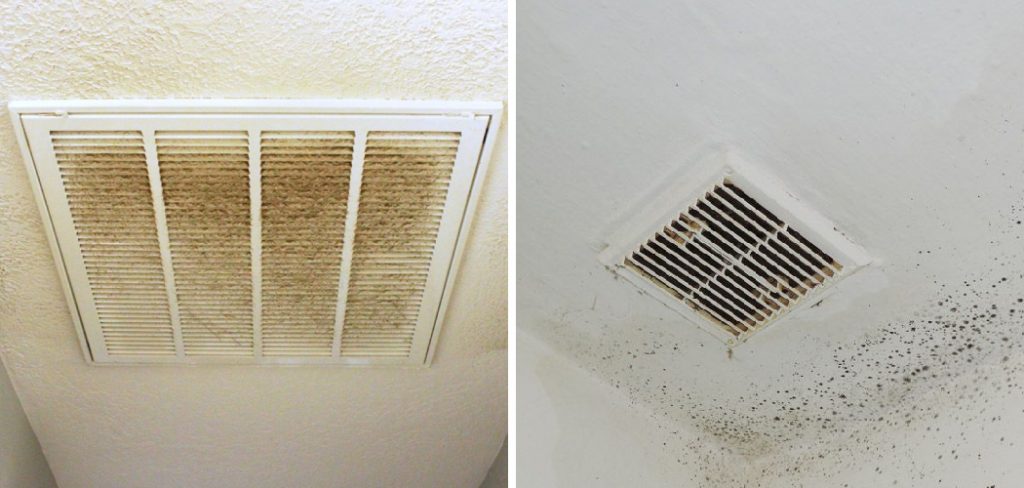
From basic dusting techniques to more thorough cleaning approaches, we’ll provide you with the knowledge and tools needed to ensure that the air you breathe remains fresh and your home stays pristine. Whether you’re aiming to improve indoor air quality, enhance the aesthetics of your ceilings, or simply maintain a healthier living environment, these insights will guide you on how to clean the often-overlooked areas around vents with ease and efficiency.
The Importance of Cleaning Ceiling Vents
Ceiling vents are an essential part of our HVAC system, responsible for regulating air flow and maintaining proper ventilation in our homes. However, they often go unnoticed when it comes to cleaning and maintenance.
Over time, dirt, dust and allergens can accumulate around these vents, causing a variety of issues such as reduced air quality, increased energy consumption and even potential health hazards. Therefore, it is important to regularly clean ceiling vents to ensure the continued functionality and cleanliness of our living spaces.
Benefits of Regularly Cleaning Ceiling Vents
Cleaning your ceiling vents on a regular basis can bring about numerous benefits. Here are some of the most significant ones:
Improved Air Quality
As mentioned earlier, dirty ceiling vents can trap dust, allergens and other particles that can circulate in the air, leading to poor indoor air quality. This can be particularly harmful for individuals with respiratory problems or allergies. Regularly cleaning your ceiling vents helps improve the overall air quality in your home, making it a healthier and more comfortable environment for you and your family.
Increased Energy Efficiency
Dirty ceiling vents can also obstruct airflow, causing your HVAC system to work harder and consume more energy in order to maintain the desired temperature. By cleaning your ceiling vents, you can improve air flow and reduce energy consumption, leading to cost savings on your utility bills.
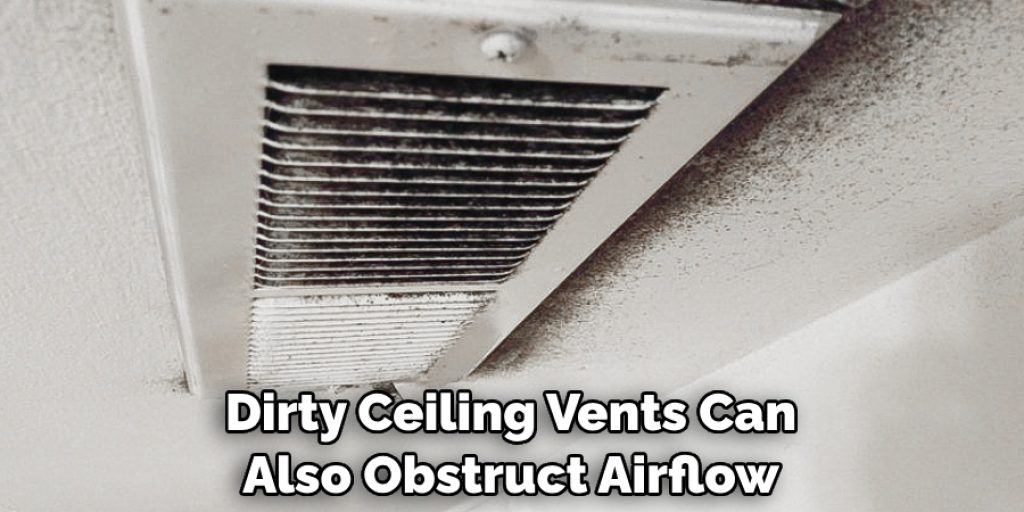
Prevention of Mold Growth
Mold is a common problem that can occur around ceiling vents if they are not cleaned regularly. The dark and damp environment around vents provides the perfect conditions for mold to thrive, which can be harmful to both your health and the structural integrity of your home. By regularly cleaning and inspecting your ceiling vents, you can prevent mold growth and ensure a safe living environment.
Prolonged Lifespan of HVAC System
Regularly cleaning your ceiling vents can also help prolong the lifespan of your HVAC system. Over time, dust and debris can accumulate inside the system, causing it to work harder and potentially leading to costly repairs or replacements. By keeping your ceiling vents clean, you are also maintaining the cleanliness of your entire HVAC system.
10 Methods How to Clean Ceiling Around Vents
1. Vacuuming
The first step in cleaning a ceiling around vents is to vacuum the area. This will help to remove any dust and debris that has accumulated on the surface of the ceiling. To do this, use an attachment on your vacuum cleaner that is specifically designed for ceilings and walls. This will ensure that you can reach all of the nooks and crannies without damaging the surface of the ceiling.
2. Dusting
Once you have finished vacuuming, it is time to dust the area with a microfiber cloth or duster. Be sure to get into all of the crevices and corners, as these are often where dirt and grime accumulate over time. If you have a high-powered fan in your home, be sure to turn it off before you begin dusting so that any dust particles don’t get blown away before you can clean them up.
3. Washing with Soap and Water
Once you have finished dusting, it is time to wash down the area with soap and water. Use a mild detergent such as dish soap or laundry detergent, as these are both gentle enough not to damage the surface of your ceiling while still being effective at removing dirt and grime from its surface. Make sure to rinse off any excess soap residue afterward with clean water.
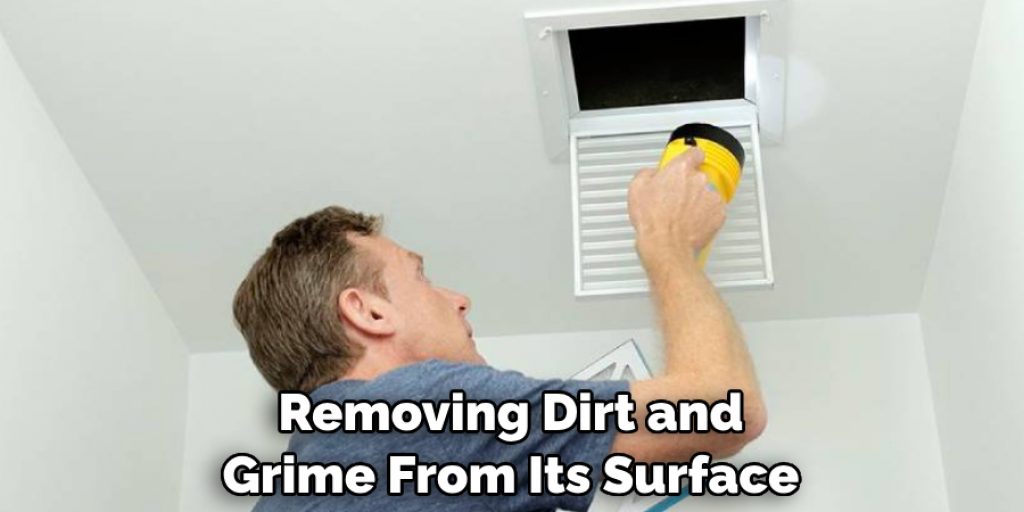
4. Using Baking Soda
Baking soda is another great option for cleaning around vents on ceilings as it is non-abrasive and won’t damage surfaces while still being effective at removing dirt and grime from their surfaces.
To use baking soda, mix together equal parts baking soda and water until it forms a paste-like consistency, then apply it directly onto the affected areas using a damp cloth or sponge before gently scrubbing in circular motions until all visible dirt has been removed from its surface. Rinse off any remaining residue with clean water afterward.
5. Using Vinegar
Vinegar is also a great option for cleaning around vents on ceilings as it contains natural antibacterial properties, which help to kill germs while also being effective at cutting through grease and grime from its surface without damaging it in any way.
To use vinegar for cleaning purposes, simply mix together equal parts white vinegar and water, then dip a cloth or sponge into this mixture before applying directly onto affected areas before gently scrubbing in circular motions until all visible dirt has been removed from its surface then rinse off any remaining residue with clean water afterward.
6. Cleaning With Rubbing Alcohol
Rubbing alcohol can also be used for cleaning around vents on ceilings as it contains antiseptic properties, which help to kill germs while also effectively cutting through grease and grime without damaging surfaces in any way whatsoever.
To use rubbing alcohol for cleaning purposes, simply pour some rubbing alcohol onto a soft cloth or sponge, then apply directly onto affected areas before gently scrubbing in circular motions until all visible dirt has been removed from its surface then rinse off any remaining residue with clean water afterward.
7 . Cleaning With Lemon Juice
Lemon juice can also be used for cleaning around vents on ceilings as it contains natural acidic properties that help to cut through grease and grime without damaging surfaces in any way whatsoever.
Plus it leaves behind a refreshing citrus scent, too! To use lemon juice for cleaning purposes, simply squeeze some fresh lemon juice onto a soft cloth or sponge, then apply directly onto affected areas before gently scrubbing in circular motions until all visible dirt has been removed from its surface then rinse off any remaining residue with clean water afterward.

8 . Cleaning With Boric Acid
Boric acid can also be used for cleaning around vents on ceilings as it contains antifungal properties that help to kill germs while also effectively cutting through grease and grime without damaging surfaces in any way whatsoever. Plus, boric acid can even prevent mold growth, too!
To use boric acid for cleaning purposes, simply sprinkle some boric acid powder onto a soft cloth or sponge, then apply directly onto affected areas before gently scrubbing in circular motions until all visible dirt has been removed from its surface then rinse off any remaining residue with clean water afterward.
9. Cleaning With Ammonia
Ammonia can also be used for cleaning around vents on ceilings as it contains powerful degreasing properties that help to cut through grease and grime without damaging surfaces in any way whatsoever plus, ammonia can even leave behind an invigorating scent, too!
To use ammonia for cleaning purposes, simply mix together equal parts of ammonia solution (available at most hardware stores) with warm water, then dip a cloth or sponge into this mixture before applying directly onto affected areas before gently scrubbing in circular motions until all visible dirt has been removed from its surface then rinse off any remaining residue with clean water afterward.
10. Hiring Professional Services
If cleaning your ceiling around vents seems like a daunting task, you can always opt to hire professional services. These companies specialize in cleaning HVAC systems and will have the necessary tools and expertise to ensure that your ceiling vents are thoroughly cleaned without causing any damage. This option may be more expensive, but it can save you time and energy in the long run.

Additionally, professional services may also offer additional services such as mold remediation or air duct cleaning to further improve the cleanliness of your home’s ventilation system. Overall, a clean ceiling around vents not only improves the aesthetic appearance of your home but also promotes better air quality and a healthier living environment.
Conclusion
Taking proper care of your vents is essential for a healthy and safe home. With these easy to follow directions, you are well on your way to having clean ceilings around your vents in no time. Not only will this improve the air quality, but it can also be rewarding to see the results of your hard work.
It may take a bit of elbow grease, but you’ll be glad you did it when all is said and done. Don’t forget about regular maintenance – dust and dirt can accumulate quickly, so make sure you’re vigilant with your cleaning routine. Remember, by tackling how to clean ceiling around vents, you now have the knowledge and confidence necessary to tackle this project head on!

